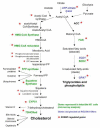Altered cholesterol and fatty acid metabolism in Huntington disease
- PMID: 20802793
- PMCID: PMC2926984
- DOI: 10.1016/j.jacl.2009.11.003
Altered cholesterol and fatty acid metabolism in Huntington disease
Abstract
Huntington disease is an autosomal dominant neurodegenerative disorder characterized by behavioral abnormalities, cognitive decline, and involuntary movements that lead to a progressive decline in functional capacity, independence, and ultimately death. The pathophysiology of Huntington disease is linked to an expanded trinucleotide repeat of cytosine-adenine-guanine (CAG) in the IT-15 gene on chromosome 4. There is no disease-modifying treatment for Huntington disease, and novel pathophysiological insights and therapeutic strategies are needed. Lipids are vital to the health of the central nervous system, and research in animals and humans has revealed that cholesterol metabolism is disrupted in Huntington disease. This lipid dysregulation has been linked to specific actions of the mutant huntingtin on sterol regulatory element binding proteins. This results in lower cholesterol levels in affected areas of the brain with evidence that this depletion is pathologic. Huntington disease is also associated with a pattern of insulin resistance characterized by a catabolic state resulting in weight loss and a lower body mass index than individuals without Huntington disease. Insulin resistance appears to act as a metabolic stressor attending disease progression. The fish-derived omega-3 fatty acids, eicosapentaenoic acid and docosahexaenoic acid, have been examined in clinical trials of Huntington disease patients. Drugs that combat the dysregulated lipid milieu in Huntington disease may help treat this perplexing and catastrophic genetic disease.
Keywords: Huntington disease; cholesterol; insulin resistance; omega-3 fatty acids; triglycerides.
Figures

References
-
- A novel gene containing a trinucleotide repeat that is expanded and unstable on Huntington’s disease chromosomes. The Huntington’s Disease Collaborative Research Group. Cell. 1993;72:971–983. - PubMed
-
- Rubinsztein DC, Amos W, Leggo J, Goodburn S, Ramesar RS, Old J, Bontrop R, McMahon R, Barton DE, Ferguson-Smith MA. Mutational bias provides a model for the evolution of Huntington’s disease and predicts a general increase in disease prevalence. Nat Genet. 1994;7:525–530. - PubMed
-
- Huntington Study Group Tetrabenazine as antichorea therapy in Huntington disease: a randomized controlled trial. Neurology. 2006;66:366–372. - PubMed
-
- Lanska DJ, Lavine L, Lanska MJ, Schoenberg BS. Huntington’s disease mortality in the United States. Neurology. 1988;38:769–772. - PubMed
-
- Saher G, Brugger B, Lappe-Siefke C, Mobius W, Tozawa R, Wehr MC, Wieland F, Ishibashi S, Nave KA. High cholesterol level is essential for myelin membrane growth. Nat Neurosci. 2005;8:468–475. - PubMed
Publication types
MeSH terms
Substances
Grants and funding
LinkOut - more resources
Full Text Sources
Other Literature Sources
Medical

